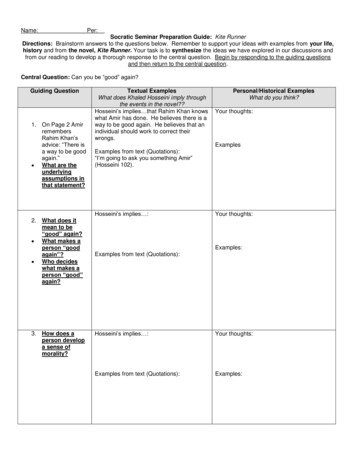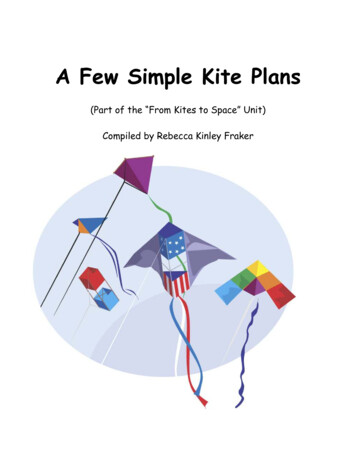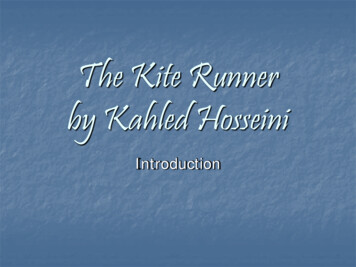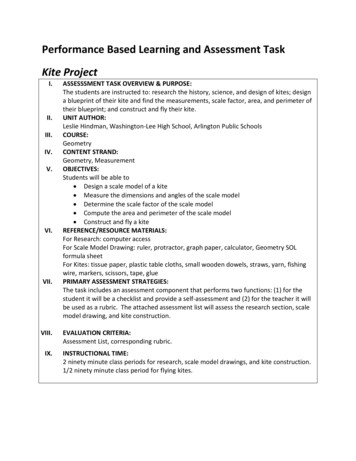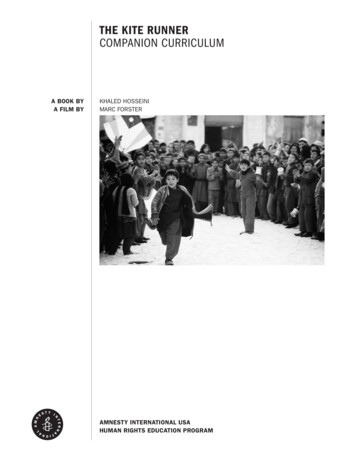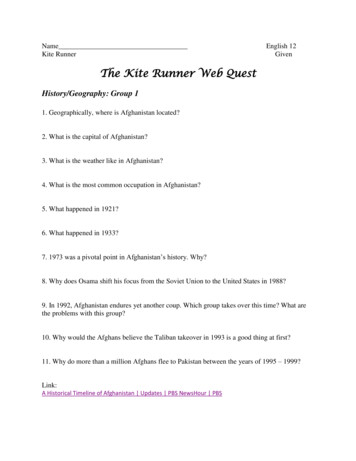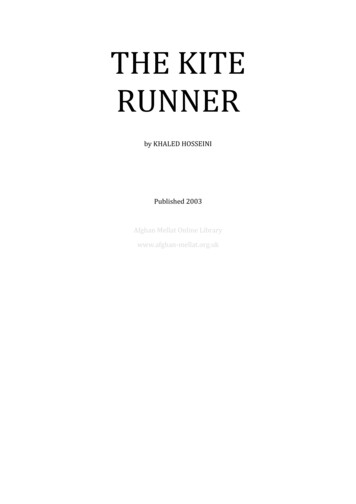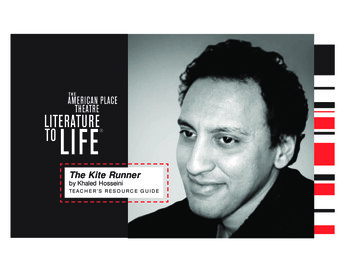
Transcription
The Kite Runnerby Khaled HosseiniTEAC H E R’S R E S O U R C E G U I D E
LITERATURE TO LIFE is a performance-based literacy program that presents professionally staged verbatim adaptationsof significant American literary works. The program gives students a new form of access to literature by bringing to life theworld of the book with performances that create an atmosphere of discovery and spark the imagination. Literature to Lifeencourages reading, writing, and critical thinking and provides a catalyst for learning and self-expression.This Literature To Life Teacher’s Resource Guide was written by professional teaching artists with vast experience implementing effective, hands-on strategies in the classroom. It is designed for educators to introduce drama-in-education totheir students, as both a pre- and post-Literature to Life performance guide. The activities presented meet the LearningStandards for English and the Blueprint for Teaching and Learning in the Arts. The exercises can be adapted (simplifiedor extended) according to the students’ special needs, maturity, interests, and abilities.Forging the connection between theatre, literature and education is no longer a privilege—it is our responsibility aseducators to not only open these doors, but to charge through them with purpose and certitude.David Kener, Executive DirectorThe American Place TheatreAll excerpts from The Kite Runner by Khaled Hosseini are reprinted here with permission. The text for the Literature to Life performance of The Kite Runner is taken directly from the book. All rights reserved.Photography by Paul Coughlin and Joe Hoyt.Theatre EtiquetteTo make the theatre-going experience more enjoyable for everyone, a code of behavior has beenestablished. When attending theatrical performances, remember these simple rules of conduct. Be on time for the performance.Do not eat, drink, or chew gum in the theatre.Turn off all cellular phones and pagers.Be sure to use the restroom BEFORE the pre-show discussion begins.Talk before and after the performance only. Remember that the people near youand on stage can hear you.Be an active participant in the pre- and post- show discussions in order to furtherdeepen your experience with Literature to Life.Appropriate responses to the performances, such as laughing and applauding, are appreciated.Act with maturity during romantic, violent, and other challenging scenes.Do not leave after the performance, a post-show discussion will follow including aQ&A with the actor.Open your eyes, ears, and mind to the entire theatrical experience!
The following exercises are designed to be used BEFORE seeing the play!Section 1: IntroductionAbout the AuthorObjective: The students will be introduced to Khaled Hosseini and The Kite Runner.Have volunteers read the following biography and letter:Khaled Hosseini was born in Kabul, Afghanistan in 1965. He is the oldest of five children. and his mother was a teacher of Farsi and History at a largegirls high school in Kabul. In 1976, Khaled’s family was relocated to Paris, France, where his father was assigned a diplomatic post in the Afghanembassy. The assignment would return the Hosseini family in 1980, but by then Afghanistan had already witnessed a bloody communist coup and theSoviet invasion. Khaled’s family, instead, asked for and was granted political asylum in the U.S. He moved to San Jose, CA, with his family in 1980. Heattended Santa Clara University and graduated from the UC San Diego School of Medicine. He has been in practice as an internist since 1996. He ismarried and has two children (a boy and a girl, Haris and Farah). The Kite Runner is his first novel.Excerpt from www.khaledhosseini.comDear Friends,Many readers see my novel, The Kite Runner, as a book about Afghanistan, a story of its violent recent past, its tragedies and upheavals, its richculture and resilient people. They tell me that this book opened for them an intimate window into my troubled homeland, and that news storiesabout Afghanistan suddenly registered with them on a deep and personal level. They ask me if this was my intent in writing this book. And I tellthem it was. But not that first day, in March of 2001, when I sat to write the opening words of this book. For me, writing has always been, firstand foremost, about storytelling. The Kite Runner came about simply because I was bewitched by a story. A story of guilt and redemption, brutality andkindness, sin and forgiveness, a story of the doomed friendship between two boys, one rich, one poor, one flawed, the other pure, with Afghanistanand her own tale of brutality and kindness as the backdrop. It was always, first and last, about story. And stage has always been a unique andpowerful medium for storytelling, direct and intimate, organic and spontaneous. And so I thank The American Place Theatre for selecting the storyof Amir and Hassan, two boys who lived in my mind and are dear to my heart. I am grateful and thrilled. Thank you for honoring me with thisperformance tonight.Khaled HosseiniLetter written to The American Place Theatre - April 12, 2005Exercise:Objective: Based on the biography and letter from the author above, as well as their first impressions drawn from the title of the novel and the setting inwhich it takes place, the students will demonstrate their immediate reactions to the book.The group forms a circle, and a copy of The Kite Runner is placed at the center. Each person has the opportunity to place their body in relation to the book,thus expressing something about how they feel based on the factors listed in the objective (e.g. A person who still feels they know nothing about the book,but is interested in finding out, may stand at a distance from the book and stare at it. A person who thinks he/she going to love it may cradle it in his arms.A person who thinks it’s going to be boring may turn his/her back to the book.)Students are encouraged to be honest about their expectations of the novel. This activity should be repeated after the students have seen the Literature toLife performance of The Kite Runner and/or read the novel.
Making Personal ConnectionsA) Yes, No, Maybe SpectrogramObjective: The students will make personal connections to the characters andthemes in The Kite Runner by relating their experiences to the novel in a safe andfun environment.Making More Connections:*Other questions that can be used for Yes, No, Maybe that will help studentsmake personal connections to the text can be drawn from the following paragraphs about what Afghans love to do. (e.g. Have you ever had a picnic inthe park? Have you ever flown a kite? Do you like to tell stories?)Exercise:Students are told that the room is split up into three categories - Yes, No, andMaybe. A question will be asked, and they will respond by moving to one sideof the room if the answer is “Yes,” the other side if the answer is “No” and themiddle part of the room if the answer is “Maybe, or I’m not Sure.” The studentscan also stand anywhere on the spectrogram between “Yes” and “No.”Questions start off general and then advance to those thematically relevant tothe novel The Kite Runner: Have you heard of the novel The Kite Runner? Do you know much about Afghanistan?Do you think that you have much in common with a student of your age livingin Afghanistan? (*They may say “no” before seeing the play, but may change their minds after getting to know the main characters.)Do you have a close childhood friend from whom you’ve grown apart?Do you have a close childhood friend with whom you still keep in touch?Have you ever had a friend who was in a different economic class than you? Have you ever had a good friend who was in a different social group than you? Have you ever had a secret that you didn’t share with anyone?Have you ever regretted a choice that you made? Have you ever felt like a “bad person”? What Afgans Love To Do:Picnics: Before the wars, Afghans spent their weekends with family and friendsgoing to public parks or to the countryside to enjoy their beautiful surroundingsand have picnics. People would travel for hours to enjoy lush and green placessuch as the Jalalabad gardens or closer to Kabul, the Paghman parks.Kites: One favorite pastime is kite making and flying. Kite flying is an art andsport at the same time. Kite makers take pride in creating kites that can reachup to 5 feet in size. The line attached to the kite is covered with glue and a finepowder of ground glass. As the challengers engage their kites up high in thesky, the goal becomes to cross lines and cut off the opponent’s kite with a sawing motion. Children love this game as they often chase the falling kite, whichthey get to keep. Talibans forbid kite making or flying during their rule–somechildren have been executed as a result.Music: Afghans adore music and playing at weddings, outdoors, or wheneverthey can. The harsh ban on music by the Taliban could lead to death if notrespected. Afghan musicians were jailed and music tapes were destroyed.Now that the Taliban no longer rule, music, folk dances and celebrations takeplace as before. Do you have a relative whom you admire? Do you think all people have flaws?Do you think it is ever okay to lie? For this last question, groups may be splitup and asked to debate their answer. They may even be asked to defend a position different from their own.Food: Afghan food is healthy and delicious. Vegetable dishes, rice, meat stewsor kabobs and fresh bread, “nan,” are all part of the menu. Cardamom tea isalways served along with a refreshing yogurt drink called “doogh” on hot days.Desserts such as fresh or dried fruits, nuts, sugar covered almonds, “nokhol,” orchick peas are nibbled on before a meal or with tea.Pastimes: Afghans like storytelling, dancing and children’s games such asmarbles. The also enjoy the national game of Buzkashi, a harsh and fastwrestling sport played on horseback and dating back to the thirteenth century.Other sports big in Afganistan are soccer, boxing, volleyball and basketball.Outdoor activities, family time and picnics are very important as well.
B) Concentric CirclesObjective: The students have a chance to further discuss some of the questionsthat they had answered silently in “Yes, No, Maybe,” by sharing stories and makingpersonal connections to the characters in a one-on-one discussion with their peers.Exercise:Participants are broken up into two groups–Group A and Group B. Group A isasked to stand in the middle of the room, forming a circle. Group B is then askedto form a circle around them. Group A turns around and finds a partner in GroupB. Each pair introduces themselves to one another and a question is asked by theteacher. After both members have responded, one of the groups is asked to movea specific amount of spaces or people to the right or left. A new question is askedby the teacher. After each question is answered, one of the groups is again askedto move a number of spaces to their right or left so as to have a new partner eachturn. Once again, questions are related to the themes of The Kite Runner.Examples include: Tell your partner whether you think you will enjoy the reading/viewing The KiteRunner based on its title and what you know about it so far, and why? (AskGroup A to move two spaces or people to their right and find a new partner.) Tell your partner what images or words come to mind when you think of“Afghanistan”? Would you consider these images or words as stereotypical,or true to reality? (Ask Group B to move four spaces or people to their left,finding a new partner.) Tell your partner about a childhood friend that you no longer speak to.How and why did you grow apart? (Ask Group A to move ) Tell your partner about a choice that you made that you now regret.(Ask Group B to move ) Tell your partner about a relative that you admire and why?(Ask Group A ) Tell your partner about a time that you lied. Do you regret the lie or do youbelieve it had to be done? (Ask Group B )*When the students view the performance of The Kite Runner, they will bereminded of their own personal connections to the themes and the stories thatthey shared.Batcha, by Joe Hoyt (Afghani boy)
Getting to Know the TextA) Broken SentencesObjective: Students will become familiar with the language in The Kite Runner.Exercise:Students are split into groups of 4. Each group is given small pieces of paper with individualwords and is asked to piece the words together to form a sentence. The first group to successfully piece the sentence together wins. Note that there may be multiple versions of the samesentence that are grammatically correct. This is repeated for a few rounds. The text is takendirectly from the novel The Kite Runner. Some of these same sentences will be used in thefrozen images, so as to reinforce the text in the novel/performance.Type out and photocopy the following sentences and cut them into individual words for eachgroup. Place the words into separate envelopes (DO NOT INCLUDE PUNCTUATION). If youhave four groups you should have 20 envelopes altogether, labelled as follows: Sentence 1Group 1, Sentence 1 Group 2, Sentence 1 Group 3, Sentence 1 Group 4, etc .“I realize I have been peeking into that deserted alley for the last twenty-six years.”“Hassan and I used to climb the poplar trees in the driveway of my father’s house and annoyour neighbors.”“Assef’s eyes flick to something behind me and widen with surprise.”“I keep stealing glances at Baba sitting with Rahim on the roof, wondering what he is thinking.”“I bury my face in the warmth of his chest and weep.”Author of The Kite Runner, Khaled Hosseini
B) Tableaux/Frozen ImagesObjective: To further familiarize the students with the text, as well as to deepen their understanding of the novel/performance using powerful physical imagery.Exercise:Participants are broken up into small groups. Each group receives an excerptfrom The Kite Runner and is asked to either literally or abstractly create atableau or frozen image which captures the essence of the excerpt. Theteacher defines “tableau” for the students as a silent frozen picture using thephysical body.Groups are given time to discuss their excerpt and collectively decide how tobest capture its imagery. They decide which characters are present in thetableau and are encouraged to be as creative as they wish, since they have notyet seen the performance.Groups are also told that when they present their frozen image, each individual(whether they represent a person, object, or symbol) will be tapped. At thistime they will speak out a phrase or sentence which gives a clue as to whothey are in the tableau or what their character may be feeling. Much of this isbased on the students’ speculation about the character using clues providedin the excerpts.Each group shares their tableau with the class (possibly in chronologicalorder). When the class yells out in unison, “1-2-3 Freeze,” the group freezesinto their tableau.As each group presents, the other participants try to figure out what is goingon in the image. After participants offer their thoughts, they tap each groupmember, listen to the phrase which they verbalize and once again try to figureout what is being portrayed in the tableau. Finally, the tableau is viewed as theexcerpt is read by a volunteer.Examples of excerpts that can be used:I became what I am today at the age of twelve, on a frigid overcast day in thewinter of 1975. I remember the precise moment, crouching behind a crumblingmud wall, peeking into the alley near the frozen creek. That was a long timeago, but it’s wrong what they say about the past, I’ve learned, about how youcan bury it. Because the past claws its way out. Looking back now, I realize Ihave been peeking into that deserted alley for the last twenty-six years.Hassan and I used to climb the poplar trees in the driveway of my father’shouse and annoy our neighbors. I talked Hassan into firing walnuts with hisslingshot at the neighbor’s one-eyed German shepherd. Hassan never wantedto, but if I asked, really asked, he wouldn’t deny me. Hassan never denied meanything. And he was deadly with his slingshot.During the school year, we have a daily routine. By the time I drag myself outof bed and lumber to the bathroom, Hassan has already washed up, prayedthe morning namaz with Ali, and prepared my breakfast. While I eat and complainabout my homework, Hassan makes my bed, polishes my shoes, irons my outfit for the day, packs my books and pencils. I hear him singing to himself in thefoyer as he irons, singing old Hazara songs in his nasal voice. Then Baba andI drive off in his black Ford Mustang.At home I open the door to the smoky study and step in. Baba and RahimKhan are drinking tea and listening to the news crackling on the radio. Theirheads turn. Then a smile plays on my father’s lips. He opens his arms. I putthe kite down and walk into his thick hairy arms. I bury my face in the warmthof his chest and weep. Baba holds me close to him, rocking me back andforth. In his arms, I forget what I’ve done. And that is good.
Bustop, by Joe HoytSection 3: Getting to Know Afghanistan50,000-20,000 BCE: Archaeological evidence indicates human civilization isbeginning to thrive in the area that will become known as Afghanistan.500 BCE: Persian leader Darius the Great extends his empire intomodern-day Afghanistan.329 BCE: Alexander the Great conquers Persia and Afghanistan. Greek rulecontinues in much of the area during the next two centuries, although unrest andrevolts are common.50 AD: The Kushan empire and its Buddhist doctrines, begin to establish themselvesin the region.550: After years of relative independence, Persian forces reassert control over thearea but continue to face intermittent revolts from native Afghan tribes.652: Arabs introduce the region to Islam, a religion that will eventuallybecome dominant.962: The Islamic era begins with the Ghaznavid Dynasty, founded by Turks and giving rise to Afghanistan’s emerging role politically and culturally in Islamic civilization.1030: The Ghaznavid empire begins to fall apart after the death of Mahmud Ghazni.1370: A series of ventures to seize power, competing kingdoms and intermittentrevolts mark the 14th and 15th centuries.1504: Babur, a founder of India’s Moghul dynasty, takes control of Kabul–and, intime, much of modern-day Afghanistan. Moghul rule introduces another religion,Hinduism, to the country and sets off more attempted nationalist revolts.1600s: On the heels of the nationalist movement of the previous century led byBayazid Roshan, another nationalist-minded revolt–this one headed by Afghanwarrior-poet Khushhal Khan Khattak–begins against the Moghul government in thelate 1600s.1708: Mir Wais, considered by some the father of Afghan independence, successfully takes over Kandahar in southern Afghanistan. His son, Mir Mahmud, invadesPersia and liberates Herat. But by 1736, the Persians start to re-establish their gripon the region.1750s: Ahmad Shah Durrani begins his rule, consolidating and enlargingAfghanistan while also governing much of India. But peace will be the exceptionover the next 100 years, as local leaders fend off Persian and Sikh invasions andfight amongst themselves.1836: The British, in corroboration with ex-king Shah Shuja, invade Afghanistan inresponse to growing Russian and Persian influence in the region. Afghan forces fightfervently against British forces, and by 1843 the nation reasserts its independence.1878: The British launch their second war against Afghanistan, but withdraw in theface of strong resistance two years later.
1885: Russian forces seize territory in northern Afghanistan. The Russians will keepmost of the area, but thereafter pledge to respect Afghanistan’s territorial integrity.Eight years later, another boundary agreement–this one between Afghanistan andBritish India–leaves several Afghan tribal areas in what is now Pakistan.1921: A third Anglo-Afghan war breaks out after anti-British forces assassinate theking. But by 1919, the war-weary British relinquish control over Afghanistan’s foreignaffairs. The new king, Amanullah, establishes diplomatic relations with several majornations and introduces reforms aimed at modernizing the country. But the movesalienate many tribal and religious leaders and generate political turmoil.1949: Afghanistan’s parliament refuses to recognize new boundaries drawn byGreat Britain establishing an independent Pakistan.1973: Daoud Khan and the Afghan Communist Party overthrow the ruling Afghangovernment and long-time king Mohammad Zahir Shah. Daoud abolishes the monarchy, presents a new constitution, ousts suspected opponents from the governmentand institutes economic and social reforms.1978: Daoud is killed and his government falls in a communist-backed coup. Masskillings, arrests and tortures ensue, and the Afghan guerrilla (Mujahidin) movementis born.1979: Anticommunist forces take control, prompting a Soviet invasion.1984: The Mujahidin, known by supporters as “freedom fighters,” begin receivingmilitary and logistical assistance from the United States and other countries.1988: The Soviet Union and United States sign the Geneva Accords, calling forSoviet withdrawal from Afghanistan and the return of refugees without fear of persecution. But the Mujahidin do not take part in the negotiations, and do not accept it.1992: The Mujahidin take over Kabul and declare Afghanistan liberated. Theyform an Islamic state, headed by the Islamic Jihad Council and ProfessorBurhannudin Rabbani.1994: The Taliban militia is born and begins to rise up against Rabbani’s governmentand its supporters. Over the next several years, the group will become the nation'sdominant political force, although by 2001 only three other countries recognizedits legitimacy.2001: Afghanistan interim government formed.2002: Hamid Karzai becomes President and peacekeeping forces enter the country.2004: A new constitution is introduced.500 BCE652103015041600187819211988
The following exercises are designed to be used AFTER seeing the play!Section 3: Post-Show ActivitiesExploring the CharactersA) Role on the WallB) Scene WritingObjective: Students will have the opportunity to explore the characters’ innerfeelings, as well as external influences.Objective: Students will practice creating original thematic written material. Theparticipants will write and act out a theme-related, two-character scene.Exercise:Exercise:Students pick one character that they were introduced to in theLiterature to Life performance of The Kite Runner. Each student createsan outline of a body by drawing it onto a small poster board anddecides which of the characters in the novel it represents. Students aretold that on the inside of the body they should write words or phrasesthat capture the internal world of the character–including thoughts,feelings, emotions, history, or anything that takes place internally. Onthe outside of the body, they are asked to write words or phrases thatcapture the external world of the character–including what peoplethink of this character, what this character shows to the world, thephysical appearance of the character, external influences or environment,other people and situations that the character interacts with, and anythingelse external.The teacher asks the class to brainstorm three categories–themes,characters, and settings–which are present in the novel and performance of The Kite Runner. The teacher helps the students define theseterms and lists the students’ responses on the board under the threedifferent categories. In groups of two, participants agree upon onetheme, one setting, and two characters from the brainstormed lists thatthey would like to further explore.After all the students have completed their outline, they may tape it onthe wall for the rest of the class to see.After the pairs have agreed on a setting, theme, and characters forthemselves, they write a silent dialogue in the following way: one participant writes one line of dialogue and then passes it onto his/her partnerwho does the same. Each participant is responsible for his/her writingof dialogue and should not consult his/her partner. The entire activityshould be silent.Groups rehearse and present their scenes.C) Hot-seatingObjective: Students will gain insight into the characters of The Kite Runner.Exercise:After each group presents, the rest of the class places the characters on the hot-seat. The class may ask the characters any questions that further theirunderstanding of the character, scene, and themes presented. The participants being hot-seated must answer the questions in character based on theinformation they know about the character as well as their imaginations.
“STAGE HAS ALWAYS BEEN A POWERFUL MEDIUM FORSTORY TELLING I THANK THE AMERICAN PLACETHEATRE FOR SELECTING THE STORY OF AMIR ANDHASSAN, TWO BOYS WHO LIVED IN MY MIND AND AREDEAR TO MY HEART. I AM GRATEFUL AND THRILLED.” KHALED HOSSEINI, AUTHOR OF THE KITE RUNNERBibliographyDrama-in-Education ResourcesBailey, Sally Dorothy. Wings to Fly. (Woodbine House, 1993)Boal, Augusto. Games for Actors and Non-Actors. (Routledge; 2nd ed., 2002)Erion, Polly. Drama in the Classroom. (Lost Coast Press, 1996)Heathcote, Dorothy and Gavin Bolton. Drama for Learning. (Heinemann Drama, 1995)Morgan, Norah and Juliana Saxton. Teaching Drama. (Heinemann, 1987)Neelands, Jonathan. Making Sense of Drama. (Heinemann Drama, 1985)Neelands, Jonathan. Structuring Drama Work. (Cambridge University Press, 2nd ed., 2000)O’Neill, Cecily and Alan Lambert. Drama Structures. (Trans-Atlantic Publications, 1982)O’Neill, Cecily and Cris Warner. Structure and Spontaneity. (Trentham Books, 2005)Spolin, Viola. Theater Games for the Classroom. (Northwestern University Press, 1986)Sklar, Daniel Judah. Playmaking. (Teachers & Writers Collaborative, 1990)Sternberg, Patricia and Antonina Garcia. SocioDrama. (Praeger Paperback March 30, 2000)Wagner, Betty Jane. Dorothy Heathcote: Drama as a Learning Medium. (Heinemann, Rev. ed., 1999)Zimmerman, Suzi. Introduction to Theatre Arts Teacher's Guide. (Meriwether Publishing, 2004)Afganistan ResourcesEmbassy of Afghanistan, Washington n for the Protection of Afghan Archaeologywww.apaa.infoAIA, Archaeology Institute of age 10242US STATE Department US Deparment of State - Focus on Afghanistan: Fact SheetsThe Kite Runner 2003 by Khaled HosseiniPublished by The Berkley Publishing Group and used by permission of the author.
We Want to Hear from YOU and your STUDENTS!THE AMERICAN PLACE THEATRE266 WEST 37TH STREET, FLOOR 22, NEW YORK, NY 10018p 212.594.4482 f ANPLACETHEATRE.ORGWWW.LITERATURETOLIFE.ORGWhat to Do After You See the PerformancePlease encourage your students to reflect on the play in some of the following ways. We would love to havecopies of some of the writings or artwork your students create!WriteWrite a letter to the actor, writer or teaching artist in response to the play.Amir liked to create alternate endings to stories and novels he read. If you were to create an alternate endingfor the performed adaptation of The Kite Runner, what would it be? (e.g. Re-write the scene between Amir andHassan, but this time let Hassan hit Amir with the pomegranate.) Khaled Hosseini used kite flying as a metaphor for Amir’s longing to gain the approval of his father and befree: “All I see is the blue kite. All I smell is victory. Salvation. Redemption. This is my one chance to becomesomeone. If there is a God, He’ll guide the winds, let them blow for me so that, with a tug of my string, I’ll cutloose my pain, my longing. I’ve endured too much.” Write about an activity you like to do, and how it may be ametaphor for something deeper. Hassan was made fun of because he was a “Hazara.” Do you see discrimination of a group of people in yourcommunity, and if so, how does it make you feel? What steps could Hassan and Amir have taken to promotechange in their community, and what can you do? Write a review of our production as if you were a journalist for a newspaper. Draw Draw images from the production.Draw a poster for our production of The Kite Runner.Create a collage of images from magazines in response to the play.Wynn Handman, Artistic Director/Co-FounderDavid Kener, Executive DirectorJennifer Barnette, Managing DirectorJillian Mojica, Office ManagerAdi Ortner, Arts Education Associate
NOTICE TO ALL TEACHERS AND CHAPERONES¾ PERFORMANCES BEGIN PROMPTLY AT 10AM OR NOON.Many of our performances sell out. This means we can have up to 1,600 students to seat. Please help us by arriving 30 minutesprior to the start of the performance. This will allow our ushers to get everyone seated and for you and your students to visit therest rooms and get settled. It is important that we begin our performances on time so that all schools can meet their lunch and/ordismissal times.¾ PLEASE CHECK LOCATION OF PERFORMANCE WHEN MAKING YOUR BUS RESERVATION.¾ The staff of the Fine Arts Center needs your help! An increasing number of students are coming into the performance space with gum,food, beverages, cell phones and portable music players. None of these items is allowed in the halls for performances. Many of theseitems are stowed in backpacks and are not easily noticed. Our goal is to offer high quality performances for young people. In order toenhance the experience, we ask for your cooperation in preventing these items from entering the hall.¾ For the comfort of all concerned, we ask that backpacks, lunches and other gear be left on the bus. Our long-standing policy of no camerasor tape recorders still is in effect.¾ At the conclusion of the performance please remain in your seats until your school group is dismissed.We hope that you and your students enjoy
The Kite Runneris his first novel. Excerpt from www.khaledhosseini.com Dear Friends, Many readers see my novel, The Kite Runner,as a book about Afghanistan, a story of its violent recent past, its traged


